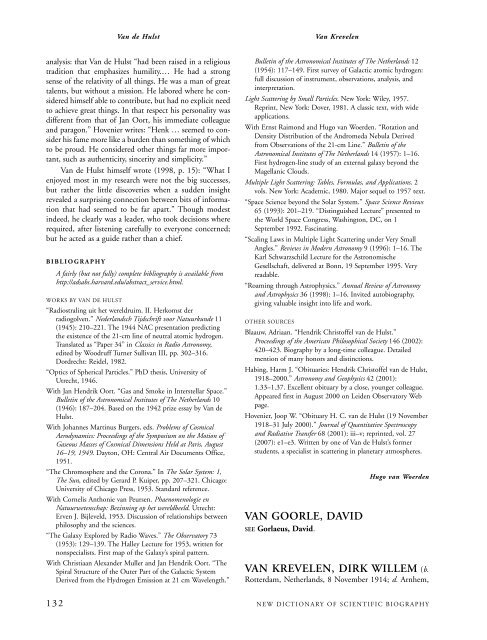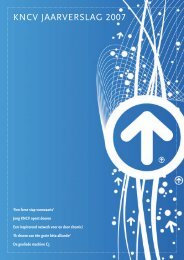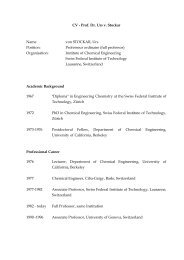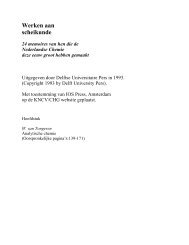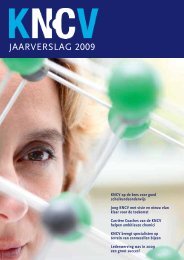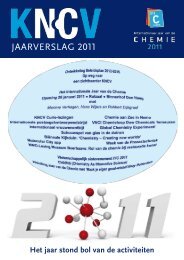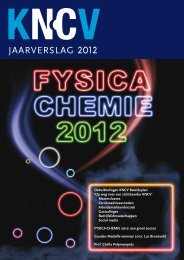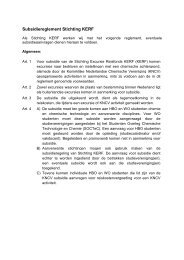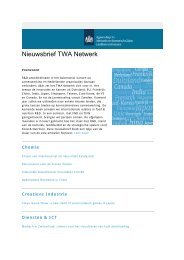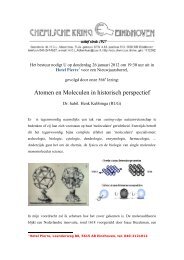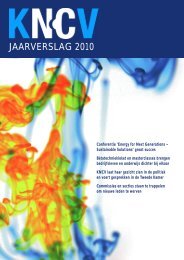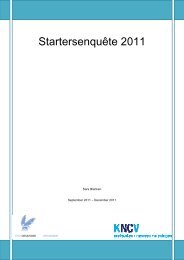VAN GOORLE, DAVID VAN KREVELEN, DIRK WILLEM (b. - KNCV
VAN GOORLE, DAVID VAN KREVELEN, DIRK WILLEM (b. - KNCV
VAN GOORLE, DAVID VAN KREVELEN, DIRK WILLEM (b. - KNCV
Create successful ePaper yourself
Turn your PDF publications into a flip-book with our unique Google optimized e-Paper software.
ndsbv7_V 9/27/07 2:59 PM Page 134Van KrevelenVan KrevelenResearch Leader at DSM. When Van Krevelen in January1940 entered the service of DSM, Frits van Iterson andDaan Ross van Lennep (manager of DSM’s chemical division)had just founded DSM’s Central Laboratory (underthe leadership of the chemist Gé Berkhoff), modeled afterthe example of the Physics Laboratory of Philips, whichwas headed by Gilles Holst. Van Iterson and Ross vanLennep wanted to establish a research laboratory that, likethe lab at Philips, would create an academic atmosphere inwhich high-level research was conducted. Initially,though, the differences between the laboratories weregreat. Whereas the Philips Laboratory in 1940 had a staffof about 520 employees, the staff of the Central Laboratoryof DSM was about 80, 20 percent of whom were academics.In the following years the DSM laboratory wouldgrow considerably. By 1941 there was a staff of about 200,including 29 academic scientists and engineers. WhenVan Krevelen left the laboratory in 1959, there werealmost 100 academic scientists and engineers and about650 employees in lower ranks.In 1940 Van Krevelen began his research activities inDSM’s physical chemistry department, which was headedby Henk de Bruijn. In 1943 Van Krevelen became adepartment manager himself, as head of the newly createdresearch department on chemical engineering. In early1948 Berkhoff decided that he would concentrate on theoverall supervision of research and development at DSM,which, next to the Central Laboratory, included variouschemical pilot plants and a research laboratory on miningtechnologies, as well as on technology transfer and licensing.Therefore a new position was created for someonewho would directly supervise the research at the CentralLaboratory. At that time the future course of the DSMresearch organization was hotly debated. Henk de Bruijn,who had visited the IG Farben laboratories at Ludwigshafenas part of a military mission in June 1947,advocated transforming the Central Laboratory into a laboratoryof basic research, and erecting additional appliedresearch laboratories, in close contact with the productiondepartments. Van Krevelen had a far more pragmaticview. He was in favor of a mix of fundamental and appliedresearch at the Central Laboratory, in permanent closecontacts with the chemical plants. Van Krevelen won thebattle, and in August 1948 he was promoted to the positionof research leader of the Central Laboratory of DSM.In early 1955 he became head of the Central Laboratory,directing not only research, but also personnel and administration,which since 1948 had been supervised by hiscolleague Jan Selman.During his years as research leader at DSM, VanKrevelen maintained a balance between fundamentalhigh-level research and research with direct economic relevanceto the company. He created an academic atmosphereat the Central Laboratory, with colloquia and studygroups, and decided that all researchers could spend 20percent of their time on topics of their own choice. In hisyearly reports he eloquently defended the relevance ofresearch against the conservative board of directors, whoin general did not support purely scientific work. At thesame time, Van Krevelen initiated research projects withdirect relevance to the production departments. The factthat research and production at DSM were located quiteclose to each other played a great role in collaborationbetween departments. Van Krevelen was in frequentexchange with chemists and engineers working in the productionplants.One of the most striking features of Van Krevelen’scareer is that, even as a manager, he continued to engagein high-level research himself. He had a few assistantsdoing the laboratory work for him, but he was active inwriting publications and books and in giving numerouslectures. Moreover, Van Krevelen did important work inthree large, but very different, fields: chemical engineering,coal science, and polymer science.Although Van Krevelen’s work was highly valued atDSM, there was no chance that he would be promoted tothe board of directors. The conservative majority of theDSM board thought that one scientist on the board—chemist Jan van Aken—was enough. They were not willingto add Berkhoff to the board, let alone his deputy VanKrevelen. Therefore, when in March 1959 Van Krevelenwas asked to become a member of the board of directorsof the Algemene Kunstzijde Unie (AKU; General RayonUnion), a far larger company than DSM, he accepted theoffer. In September 1959 Van Krevelen joined the boardof directors of AKU with the special task of supervisingthe research and development activities of the company.Surprisingly, in his new and demanding managerial role,he continued to be actively engaged in research.Chemical Engineering. In June 1940, soon after he hadentered the services of DSM, Van Krevelen was given thetask of studying the removal of carbon dioxide (CO 2),hydrogen sulfide (H 2S), and other gases from coal gaswith the help of an ammonia (NH 3)–water mixture. Thiswas necessary because coal gas had to be purified before itcould be used for lighting purposes by the households inthe region, but also because DSM had planned to useCO 2as a feedstock for the production of soda and urea.The problem was quite new to Van Krevelen. It involvedthe study of chemical engineering problems such as masstransfer (diffusion) in combination with chemical reactions.Waterman had been one of the first professors ofchemical technology on the Continent who had used theAmerican approach to chemical engineering in his lectures,following a visit to the United States in the 1920s;he introduced the concepts of “unit operations” and “unit134 NEW DICTIONARY OF SCIENTIFIC BIOGRAPHY
ndsbv7_V 9/27/07 2:59 PM Page 135Van KrevelenVan Krevelenprocesses” to the Netherlands. Van Krevelen had of courseheard these lectures, but he was not really familiar withthe study of unit operations, or of other chemical engineeringtopics.Consequently, Van Krevelen started to study bookson chemical engineering, such as William H. Walker,Warren K. Lewis, and William H. McAdams’s Principlesof Chemical Engineering (3 rd ed., 1937), Walter L. Badgerand Warren L. McCabe’s Elements of Chemical Engineering(1931), and Thomas K. Sherwood’s Absorption andExtraction (1937). Together with his research assistant JanHoftijzer (called Hoftyzer in English sources), he successfullysolved the problems concerning the purification ofcoal gas in 1941; in the following years they worked onimproving their theoretical understanding of the process.In 1946 Van Krevelen and his colleague Honoré A. J.Pieters published a book on the new process of coal gaspurification developed at DSM. Two years later Van Krevelenand Hoftijzer published their theoretical views on thecombined effects of mass transfer and chemical reactions.This represented a great breakthrough in chemical engineering,and their publication was one of the first paperson that particular topic. Their paper became a classic, andthe “Van Krevelen-Hoftyzer diagram” on chemical gasabsorption (1948), informally called the “shunting yard”by chemical engineers, was often quoted in the literature.The reason that the Van Krevelen–Hoftijzer paperbecame a classic had to do with the improved theoreticalunderstanding of chemical engineering that Van Krevelenhad acquired during World War II. In 1942 Van Iterson,who was on the supervisory board of the Middelbare TechnischeSchool (Polytechnic School) at Heerlen, near DSM,asked Van Krevelen to introduce a course on chemicalengineering at that school. Until that time chemical engineeringhad only been taught in the Netherlands at theTechnological University at Delft (by Waterman, until theNazis forced him to resign in October 1940, and byWillem J. D. van Dijck, a part-time professor who workedat Royal Dutch/Shell), and at the Polytechnic School atDordrecht. Van Krevelen was thus among the first in theNetherlands who taught about unit operations and unitprocesses. In 1943 Adriaan Klinkenberg and HermanMooy of the development group within the engineeringdepartment of Royal Dutch/Shell at The Hague publisheda paper in which they argued that there were strong analogiesbetween the transfer processes of momentum, energy(heat), and matter. They rewrote the fundamental conservationlaws of momentum, energy, and matter in such away that similar equations resulted, with four differentterms: changes as a function of time; changes by convection;changes by diffusion; and changes by production (forinstance, as a result of an external forces, in the case ofmomentum, or by a chemical reaction, in the case of theproduction of heat and matter). They studied these equations,and their boundary conditions, by introducingdimensionless groups, such as the Reynolds number or theNusselt number, thus combining in a creative way thestudy of transport phenomena with P. W. Bridgman’s“dimensional analysis” and M. Weber’s “theory of similitude,”which was crucial for the scaling-up of laboratoryexperiments to the level of production plants. By so doing,they succeeded in providing a well-structured and rathercomplete picture of the different dimensionless groups thatplayed important roles in chemical engineering.Van Krevelen was delighted by the paper of Klinkenbergand Mooy, and he completely restructured his chemicalengineering course at the Heerlen Polytechnic School.In his lecture notes, called Een nieuw ordenend beginsel bijde studie der technologische bewerkingen (A New OrderingPrinciple in the Study of Technological Operations), hesystematically extended the approach of Klinkenberg andMooy as a basis for the understanding of unit operations.In Van Krevelen’s view, all unit operations—such as distillation,ion exchange, crystallization, filtration, mixing,and gas absorption—could be understood in terms of fourfundamental processes: transfer of mass, transfer ofmomentum, transfer of energy, and transfer of electriccharge (which he had added). And, even more systematicallythan Klinkenberg and Mooy, Van Krevelen developeda complete overview of all possible dimensionlessgroups, introducing a uniform notation for them. Thissystematic approach would also characterize much of VanKrevelen’s later work.After 1948 this new, more fundamental understandingof unit operations was introduced at Delft TechnologicalUniversity by Hans Kramers, the successor to VanDijck as professor of chemical engineering. His course on“transport phenomena” of momentum, energy, and massfollowed the classification systems introduced by Klinkenberg,Mooy, and, probably, Van Krevelen, but went intofar greater detail with respect to the quantitative empiricalstudy of the transfer processes. R. Byron Bird, who in1956 worked in Kramers’s laboratory as a Fullbright lecturer,followed Kramers’s example in his very successfultextbook on Transport Phenomena (1960), which he wrotewith Warren E. Stewart and Edwin N. Lightfoot.Through the use of that text, the approach pioneered byKlinkenberg, Mooy, and Van Krevelen became a standardingredient of all chemical engineering curricula in theUnited States and Europe.Theoretical studies such as the one done by Klinkenbergand Mooy, and by Van Krevelen, were typical ofmuch of the research work done during World War II inthe Netherlands. Because of the war, the construction ofnew installations slowed down, or even came to a halt, asin the case of Royal Dutch/Shell. Without projects withtight deadlines, several industrial scientists and engineersNEW DICTIONARY OF SCIENTIFIC BIOGRAPHY 135
ndsbv7_V 9/27/07 2:59 PM Page 136Van KrevelenVan Krevelenembarked on theoretical studies. Indirectly, these studieshad great practical relevance. The theory of gas-liquidreactions and the improved processes for gas absorptiondeveloped by Van Krevelen and Hoftijzer clearly built onVan Krevelen’s new approach to unit operations with thehelp of dimensionless parameters. His well-organized“shunting yard” graph was the result of an intelligentchoice of three dimensionless parameters that providedinsight into the relative importance of the physical diffusionand of the rate of the chemical reaction of the components.Van Krevelen coined the term “Sherwoodnumber” for one of these parameters, named after hisAmerican colleague Thomas K. Sherwood.In 1941 and 1942 Van Krevelen also started a thoroughempirical and theoretical study of nitric acid manufacture,one of the key products of the chemical plants ofDSM. Absorption of gases by liquids played a significantrole in that chemical process. Van Krevelen developed amathematical model of nitric acid production, whichgreatly improved the process control of the existing nitricacid plants of DSM, and which also led to the design of acompletely new plant, which was built between 1947 and1951. The new process was a success, and several licenseswere sold to chemical companies in England, Germany,Portugal, South Africa, Egypt, and India.In 1946 and 1947 Van Krevelen made a three-monthstudy tour through the United States to learn about thelatest developments in chemical engineering. He metmost of the leading figures in the field—such as T. K.Sherwood, W. K. Lewis, W. H. Walker, W. L. McCabe, T.H. Chilton, A. P. Colburn, O. A. Hougen, and K. M.Watson—and was elected as an active member of theAmerican Institute of Chemical Engineers in 1947.Between 1947 and 1951 Van Krevelen published aboutthirty papers on gas absorption and on many other aspectsof chemical engineering, such as the dissolution of solids,the drying of solids, fluidization, and the principles ofchemical reaction engineering. In 1951 Van Krevelen wasone of the founding editors of the journal Chemical EngineeringScience. Two years later, the European Federationof Chemical Engineering (EFCE) was established, andVan Krevelen took an active part in organizing its firstcongress, the First Congress on Chemical Reaction Engineering,which was held in Amsterdam in 1957. At thatcongress the EFCE Working Party on Chemical ReactionEngineering was formally established, and Van Krevelenbecame its first chairman; the term chemical reaction engineering,which refers to the interplay of chemical engineeringand the study of reaction kinetics, had beencoined by Van Krevelen himself.In addition to his other fields of research (see below),Van Krevelen continued to contribute to chemical engineeringduring the 1950s and 1960s. Between 1951 and1971 he published more than fifty papers. One important(and still cited) paper was a study with his colleague PieterMars of the mechanism of oxidation reactions over oxidiccatalysts, such as vanadium oxide (which plays a role, forinstance, in sulfuric acid manufacture). Mars and VanKrevelen discovered that oxidation takes place via a twostepmechanism: first, the absorbed reactant is oxidized bythe oxygen present in the crystal lattice of the catalyst, followedby desorption of the product; in a second step, thereduced catalyst is oxidized by oxygen from the gas phase.This so-called “Mars–Van Krevelen mechanism” appearedto have a quite universal significance, as it plays a role innumerous catalytic reactions. In 1958 Mars, who workedat the Central Laboratory of DSM, received his PhD fromthe Technological University at Delft on the basis of hisresearch on the mechanism of oxidation reactions, with thechemist Jan de Boer and Van Krevelen as his supervisors.Another often-cited publication by Van Krevelenwith great relevance to industrial chemical reactions washis work on the “estimation of the free enthalpy (Gibbsfree energy) of formation of organic compounds fromgroup contributions,” published in 1951, together withhis assistant Huub Chermin. Building on Waterman’sgraphical-statistical method, Van Krevelen showed thatthe group contributions were additive—a fact that greatlyhelped to predict the course of new industrial processes.Later, in his work on polymers, Van Krevelen wouldextend this “atomic group approach” to other physicalparameters.After Van Krevelen left DSM for AKU, he introducedhis expertise in chemical engineering to that company.Although a member of the board of directors, hesupervised research by Rob Vroom on the chemical reactionengineering aspects of the viscose rayon spinningprocess, and coauthored several papers on polymer processing.For his “fundamental research on chemical reactionengineering” Van Krevelen was awarded an honorarydoctorate by the Technische Hochschule Darmstadt in1966.Coal Science. After Van Krevelen had been promoted toresearch manager of the Central Laboratory of DSM,Berkhoff asked him, at the end of 1948, to become theDutch representative to the European Working Party onCoal Classification. As a result, Van Krevelen decided toembark on a second large field of research, namely the scientificstudy of coal. Apart from the direct relevance to thework of the Working Party, this was also a strategic choicebecause Dutch State Mines primarily was a mining company,though it had a large chemical component, and themining operations of the company were the primary concernof the board of directors. By taking coal as his topicof research, Van Krevelen was able to show the relevance136 NEW DICTIONARY OF SCIENTIFIC BIOGRAPHY
ndsbv7_V 9/27/07 2:59 PM Page 137Van KrevelenVan Krevelenof chemical research to the mining engineers and coalmerchants of the board of DSM, a factor that facilitatedthe expansion of the Central Laboratory during the1950s.The cornerstone of Van Krevelen’s coal research wasthe fruitful application to coal of the graphical-statisticalmethod that his former supervisor Waterman had appliedto oil products. Traditionally the properties of crude oiland of oil fractions had been characterized by fractionaldistillation and by measuring its specific density. For thehigher boiling fractions of oil, these methods were far toorough. Before the introduction to the oil industry, in the1950s, of gas chromatography, mass spectroscopy andNMR, other methods therefore had to be developed tocharacterize oil fractions. Of these, Waterman’s methodwas one of the most successful.In 1932 Waterman had published the idea that it wasnot necessary to characterize oil fractions by identifying alltheir dozens of components, but that it was sufficient todetermine the statistical averages of the three most importantstructural characteristics of molecules in oil: the percentageof carbon in the aliphatic parts of the molecules(alkanes; paraffines); the percentage of carbon in thecycloalkane (naphtenic) parts of the molecules; and thepercentage of carbon in the aromatic parts of the molecules.Together with his students Jozef C. Vlugter andHendrik A. van Westen, Waterman presented his resultsin graphs in which the hydrogen percentage was plottedagainst the average molecular weight for different “ringindices,” that is, the average number of naphtenic ringsper molecule. It appeared that with the help of these threeparameters, crude oils and oil fractions could be characterizedquite accurately. Between 1932 and 1942 Watermanand his students also showed that by measuring physicalparameters—such as the refraction (n), the density (d),and the average molecular weight (M) (the so-called n-d-M method)—and several other parameters such as the viscosity(ν)—the hydrogen percentages and ring indicescould be calculated, so that oil fractions could be characterizedwith sufficient precision by physical measurementsalone. Later in his career Waterman also applied thesemethods to the characterization of chemical processessuch as hydrogenation and aromatization.Van Krevelen transferred Waterman’s methodology tothe investigation of coal. As early as 1950 he published aseminal paper in the British journal Fuel that would influencethe entire field of coal research for decades. With thehelp of two seemingly simple, dimensionless ratios—theatomic hydrogen to carbon (H/C) ratio, and the atomicoxygen to carbon (O/C) ratio—Van Krevelen constructeda diagram that summarized numerous publications as wellas the extensive empirical investigations done by his assistants.On the one hand, the diagram permitted therational classification of pre-stages of coal formation anddifferent types of coal, such as wood, cellulose, lignin,peat, brown coal, different grades of bituminous coal, andanthracite. On the other hand, the diagram showed differentreaction paths, such as decarboxylation, dehydration,and demethanation, which played a role both during naturalcoal formation (coalification) and in the industrialprocesses of coal gas production and coke manufacture(carbonization), hydrogenation, and oxidation.With the help of the “Van Krevelen diagram,” importantnew insights on coalification and on industrialprocesses could be gained, and many of these new insightswere already in Van Krevelen’s 1950 publication. Thatwork accelerated Van Krevelen’s very productive researchtrajectory in coal science. Between 1948 and 1965 hewould publish over a hundred papers on coal and coalproducts. As a result, the “Van Krevelen diagram” foundits way into geology and geochemistry, where it is appliedtoday also to the study of the formation of oil and naturalgas, and to the study of coal products such as coke, gas,and artificial gasoline. It helped manufacturers to understandwhich type of coal was best suited for the productionof a particular final product.In 1957 Van Krevelen summarized his research in thebook-length monograph Coal Science: Aspects of Coal Constitution,which he published with his assistant Jan Schuijer.The book became a great success. In 1961 VanKrevelen published a thoroughly revised edition under thetitle Coal: Typology, Chemistry, Physics, Constitution. Thegraphical-statistical method and the “Van Krevelen diagram”played a key role in these books. After his retirementfrom industry in 1976, Van Krevelen againpublished a revised edition, in 1981. The book had to bereprinted in 1982, and again in 1984. In 1993, at the ageof seventy-nine, Van Krevelen published a fourth, updatededition of Coal: Typology, Chemistry, Physics, Constitution.Through these books and his numerous papers Van Krevelendominated the field of coal science for over thirtyyears. In 1954 he was awarded the medal of the Universityof Liège for his work on coal, and in the same year hewas awarded the Coal Science Medal of the British CoalUtilisation Research Association. In 1959 he was elected aFellow of the Institute of Fuel. In a generalized form, theH/C and O/C “Van Krevelen diagrams” are today alsoused in mass spectrometry.Professor of Fuel Technology and PolymerizationProcesses at Delft. In 1952 Gerard A. Brender à Brandis,the part-time professor of fuel technology at the TechnologicalUniversity of Delft, retired, and Van Krevelen wasinvited to succeed him. After the board of directors ofDSM gave him permission to teach two days a months atDelft, Van Krevelen in October 1952 was formallyNEW DICTIONARY OF SCIENTIFIC BIOGRAPHY 137
ndsbv7_V 9/27/07 2:59 PM Page 138Van KrevelenVan Krevelenappointed as professor of chemical technology, with thespecial task of teaching about the technology of solid andliquid fuels and the associated production of energy. Heheld this professorship until his retirement from the TechnologicalUniversity of Delft in 1980.During his professorship Van Krevelen lectured on allthree scientific fields to which he made major contributions:from 1953 to 1957, and in 1959 and 1961, he lecturedon fuel technology; in 1958, 1960, and 1963 hegave courses on chemical reaction engineering; and hetaught on the process technology of polymers in 1962 andfrom 1964 to 1980. After his move to AKU, in 1959, thesubject of his professorship at Delft was formally changedto the process technology of polymers. For the supervisoryboard of AKU this had been a pre-condition for grantingpermission to Van Krevelen to combine his membershipon the board of directors with a part-time professorship atDelft.Although a part-time professor, Van Krevelen supervisedthe considerable number of twenty-three dissertations.In most cases these PhD students were staffmembers of the research organizations of DSM (and,later, AKU), who did their research in industry, supervisedby Van Krevelen, and who were awarded the doctorate atDelft when their results had enough substance and coherence.Between 1952 and 1966 Van Krevelen supervisednine PhD students in coal research, between about 1955and 1960 four PhD students in chemical engineering, andbetween about 1961 and 1977 ten PhD students in polymerproduction and processing. Several of his PhD studentsand research assistants later became universityprofessors themselves: Rinus Groenewegen and JaapSmidt in molecular spectroscopy (which they had appliedat DSM to the study of coal); Jan Schuijer and LeenStruik in the technology of polymers; Piet Mars in catalysis;and Rob Deelder in analytical chemistry.Member of the Board of Directors of AKU and AKZO.When, on 1 September 1959, Van Krevelen succeeded JanWeeldenburg, who had just died, as board member ofAKU with the overall responsibility for research, heentered a company that differed from DSM in manyrespects. In contrast to DSM, AKU had been a multinationalcompany for many decades. Founded in 1929 as aholding company that united the activities of the Dutchrayon firm Enka and the German Vereinigte GlanzstoffFabriken, AKU in 1959 had plants for fiber production inGermany, Austria, Britain, Spain, Italy, the United States,Mexico, and the Netherlands. Even before World War II,AKU was one of the leading synthetic fiber producers,together with companies such as Du Pont and IG Farben.Around 1960 its major fiber was still rayon, but nylon-6(Enkalon®), produced from caprolactam made by DSM,had been produced since the early 1950s, and the companywas constructing plants for glass fibers (togetherwith Pittsburgh Plate Glass) and polyesters (Terlenka®)based on dimethyl terephtalate (together with Amoco). In1960 the central research and development laboratoriesnear the AKU headquarters at Arnhem had a staff of1,075 employees. There were also large research laboratoriesin Germany and the United States. Van Krevelen nowhad responsibility for a research and development organizationthat was about four times as large as the CentralLaboratory of DSM.The 1960s were a period of vigorous expansion of thechemical and synthetic fibers industries. Through hugeinvestment programs and mergers, companies tried toimprove their economies of scale. Against that backgroundVan Krevelen was a strong advocate of a mergerbetween AKU and DSM. He had the vision that the backwardintegration of AKU into the domain of organicchemistry and fiber intermediates would strengthen thetechnological and economic basis of the company. Therewas a strong synergy, because DSM made growingamounts of caprolactam for AKU’s nylon production. Atleast three times during the 1960s Van Krevelen and hiscolleagues negotiated seriously with Van Krevelen’s formerboss Jan van Aken and the other board members of DSM.Although both Van Krevelen and Van Aken were stronglyin favor of the merger, members of DSM’s advisory boardwere against the integration of the state-owned DSM intoa private corporation, in view of the social responsibilityfor the miners at a time when all Dutch coal mines wereclosing their gates. To Van Krevelen’s great disappointment,the negotiations between AKU and DSM came toa final end in early 1969.Only a few months later, AKU merged with KoninklijkeZout Organon (KZO), a company that was a conglomerateof pharmaceutical (Organon and Noury vander Lande), coatings (Sikkens), and chemical (Ketjen andKoninklijke Zout) companies. The result of the mergerwas incorporated as AKZO (since 1994, Akzo Nobel).Van Krevelen remained a member of the board of directors,and he was, as a result of the divisional structureintroduced shortly after the merger, at the same time presidentof AKZO Research and Engineering. In that role hehad the difficult task of integrating the research and developmentlaboratories of the different companies that werenow part of AKZO. When Van Krevelen retired fromAKZO in 1976, the integration process was still incomplete.He was succeeded by Hans Kramers, his former colleagueas professor of chemical engineering at Delft.Polymer Science. As leading manager and scientist atAKU, Van Krevelen decided to focus his scientific activitieson polymer science. This field was not completely138 NEW DICTIONARY OF SCIENTIFIC BIOGRAPHY
ndsbv7_V 9/27/07 2:59 PM Page 139Van KrevelenVan Krevelennew to him. At DSM he had been involved in the supervisionof research on the fiber intermediates caprolactamand nylon salt, and on the polymerization of these intermediates.He also had been involved in the acquisition ofthe technology of the production of high-density and lowdensitypolyethylene, from the German chemist KarlZiegler and the British company Imperial ChemicalIndustries (ICI), as well as in organizing the research activitiesthat went hand in hand with those acquisitions.He again formed a small group of private assistants(including his long-time assistant Jan Hoftijzer, who hadfollowed him from DSM to AKU); he was in close contactwith other research scientists at AKU, and he lecturedat Delft on polymer science and technology. As the combinedresult of these activities, Van Krevelen succeeded forthe third time in mastering a new field. Between 1960 and1978 he published about forty papers on polymers andpolymer processing. In 1972 he summarized his results,and numerous papers by others, in a handbook written incollaboration with Hoftijzer, called Properties of Polymers:Correlations with Chemical Structure. Again, he built onWaterman’s graphical-statistical method, on his ownapproach developed in his book on Coal, and on the seminalpublication that he wrote with Chermin on the groupcontributions to the Gibbs free energy of molecules. VanKrevelen and Hoftijzer showed that many physical propertiesof polymer molecules could be estimated by summingthe contributions made by the various structuralgroups in the polymer repeat unit. The correlations weresemi-empirical in nature. In cases of strong interatomicand intermolecular interaction between the groups, orbetween the molecules, the physical properties are notadditive. But in those cases, Van Krevelen showed, thedeviations from the additive rule again followed certainregularities.His book Properties of Polymers was consideredgroundbreaking by organic chemists and chemical engineersworking in industry, because it brought order to alarge and rapidly developing new field. Van Krevelen realizedthat the book was not for the polymer scientistproper, “its design being too empirical for him and toomuch directed to practice” (Van Krevelen and Hoftyzer,2nd ed., 1976, p. v). The group additive method used inthe book is known as the “Van Krevelen method” (or“Van Krevelen–Hoftyzer method”). Because his methodwas easy to use and covered a wide range of properties, itwas quickly accepted by many scientists working in industry.In 1976 Van Krevelen had already published a secondedition, reprinted in 1980 and 1986, and in 1990 a thirdedition came out, which was reprinted in 1997. His workclearly went beyond the skillful summarizing of knownresults. Many original empirical studies were included inhis books. In 1975 Van Krevelen and Hoftijzer publishednew work on the viscosity of so-called non-Newtonian(polymer) fluids. The relationship they found between thetemperature, the chemical structure of the polymer unit,and the viscosity is known as the “Van Krevelen–Hoftyzerrelationship.”Retirement and Awards. After his retirement from AKZOin 1976, Van Krevelen remained active for many years.From 1980 to 1983 he was international research advisorto the oil company Shell, and from 1980 to 1986 he alsowas research advisor and president of the advisory boardof Norit, a company active in the production of adsorbents.In his spare time Van Krevelen studied the historyof Egypt and other ancient civilizations.In 1977 he was awarded the Chemistry Prize of theSociety of the Dutch Chemical Industry for his great contributionsto the development of that industry in theNetherlands. In 1984 he received the honorary doctorateof the Technological University Delft, in view of hisachievements in coal technology, polymer technology, andthe fundamentals of chemical engineering. Seven yearslater, in 1991, he became an honorary member of theRoyal Dutch Chemical Society. Dick van Krevelen diedon 27 October 2001 after a short period of illness followinga stroke.BIBLIOGRAPHYThe Regionaal Historisch Centrum Limburg, Maastricht, theNetherlands, houses the archive of the DSM company, includingthe personal files of D. W. van Krevelen (until 1959). For abibliography of van Krevelen’s publications (up to 1980), see hisIn Retrospect: Een keuze uit de voordrachten, (Amsterdam:Meulenhoff, 1980), pp. 281–321. A copy of the typescript D. W.van Krevelen, Een nieuw ordenend beginsel bij de studie dertechnologische bewerkingen (n.d., n.p. [ca. 1946–1950]) is inthe possession of the author. Together with James Small, theauthor interviewed Dick van Krevelen on 4 March 1997.WORKS BY <strong>VAN</strong> <strong>KREVELEN</strong>“De geïnduceerde pyrolyse van methaan.” Dissertation,Technological University of Delft, 19 December 1939.With H. A. J. Pieters. The Wet Purification of Coal Gas andSimilar Gases by the Staatsmijnen-Otto-Process. New York:Elsevier, 1946.With P. J. Hoftijzer. “Kinetics of Gas-Liquid Reactions. Part I:General Theory.” Recueil des Travaux Chimiques des Pays-Bas67 (1948): 563–568.“Graphical-statistical Method for the Study of Structure andReaction Processes of Coal.” Fuel 29 (1950): 269–283.With H. A. G. Chermin. “Estimation of the Free Enthalpy(Gibbs Free Energy) of Formation of Organic Compoundsfrom Group Contributions.” Chemical Engineering Science 1(1951): 66–80, 238.With P. Mars. “Oxidations Carried Out by Means of VanadiumOxide Catalysts.” Proceedings of the Conference on OxidationNEW DICTIONARY OF SCIENTIFIC BIOGRAPHY 139
ndsbv7_V 9/27/07 2:59 PM Page 140Van KrevelenVan StraatenProcesses, Held in Amsterdam, 6–8 May 1954. SpecialSupplement to Chemical Engineering Science 3 (1954): 41–57.Coal: Typology, Chemistry, Physics, Constitution. Amsterdam:Elsevier, 1961. [First edition, 1957, published (with JanSchuijer) as Coal Science: Aspects of Coal Constitution.] 3 rd ed.,1981; 4 th ed., 1993.“Waterman en de steenkoolchemie.” In De Oogst: een overzichtvan het wetenschappelijk werk van Prof. dr. ir. H. I. Waterman,te zamen gebracht ter gelegenheid van zijn aftreden alshoogleraar in de chemische technologie aan de TechnischeHogeschool te Delft, pp. 24–29, n.p., n.d. [Delft, 1959].Werdegang und Weg in der chemischen Technologie:Arbeitserinnerungen und Ausblick. Darmstadt: TechnischeHochschule, 1966. Lecture given on the occasion of receivingthe honorary doctorate.With P. J. Hoftyzer. Properties of Polymers: Correlations withChemical Structure. Amsterdam: Elsevier, 1972; 2 nd ed., 1976;3 rd ed., 1990.Selected Papers on Chemical Engineering Science. Amsterdam:Elsevier, 1976.In Retrospect: Een keuze uit de voordrachten. Amsterdam:Meulenhoff, 1980. With a comprehensive bibliography of hisover 250 publications up to 1980.Sleutelwoorden in de proefondervindelijke wijsbegeerte. Rotterdam:Bataafsch Genootschap, 1987.“Professor Hein Israel Waterman, 1889–1961: Onderzoeker—Vernieuwer—Leermeester.” In Waterman Symposium: AulaTU Delft, 28 April 1989, voordrachtenbundel, 72–84. Delft:Technische Universiteit Delft, 1989.“Vijftig jaar activiteit in de Chemische Technologie.” In Werkenaan scheikunde. 24 memoires van hen die de Nederlandsechemie deze eeuw groot hebben gemaakt, 243–263. Delft: DelftUniversity Press, 1993. His autobiography.OTHER SOURCESBoelhouwer, C. “De Waterman ringanalyse.” In Chemie achter dedijken: Uitvindingen en uitvinders in de eeuw na Van‘t Hoff,edited by Herman van Bekkum and Jan Reedijk, 44–45.Amsterdam: Edita KNAW, 2001.———. “Hein Israël Waterman: kringen van hoge druk.” InDelfts goud: Leven en werken van achttien markantehoogleraren, edited by K. F. Wakker et al., 64–79. Delft:Technische Universiteit Delft, 2002.Challa, Ger. “Polymeren.” In De geschiedenis van de scheikunde inNederland 3: De ontwikkeling van de chemie van 1945 tot hetbegin van de jaren tachtig, edited by Ernst Homburg andLodewijk Palm, 231–241. Delft: Delft University Press,2004.Fortuin, Jan M. H. “Procestechnologie en chemische industrie.”In De geschiedenis van de scheikunde in Nederland 3: Deontwikkeling van de chemie van 1945 tot het begin van dejaren tachtig, edited by Ernst Homburg and Lodewijk Palm,61–83. Delft: Delft University Press, 2004.Homburg, Ernst. Speuren op de tast: Een historische kijk opindustriële en universitaire research. Maastricht: UniversiteitMaastricht, 2003. A history of research and development inthe Netherlands.Klinkenberg, A., and H. H. Mooy. “Overzicht der dimensieloozekengrootheden, die optreden bij het transport van impuls,warme en stof.” Nederlandsch Tijdschrift voor Natuurkunde 10(1943): 29–50.———, and H. H. Mooy. “Dimensionless Groups in FluidFriction, Heat, and Material Transfer.” Chemical EngineeringProgress 44 (1948): 17–36. An enlarged translation of their1943 pubication.Lintsen, Harry W., ed. Research tussen vetkool en zoetstof: Zestigjaar DSM Research 1940–2000. Zutphen: Walburg Pers,2000.Mars, Pieter. “De kinetica van oxydatiereacties opvanadiumhoudende katalysatoren.” PhD diss., TechnologicalUniversity of Delft, 12 March 1958.Moulijn, J. A., and H. van Bekkum. “De alleskunner. VanKrevelen: Recordhouder chemische vernoemingen.” InChemie achter de dijken. Uitvindingen en uitvinders in de eeuwna Van ‘t Hoff, edited by Herman van Bekkum and JanReedijk, 46–47. Amsterdam: Edita KNAW, 2001.Mijs, Wim. “In Memoriam Prof. Dr. D. W. van Krevelen(1914–2001).” Chemisch 2 Weekblad (17 November 2001):11.Rooij, Arjan van, The Company That Changed Itself: R&D andthe Transformations of DSM. Amsterdam: AmsterdamUniversity Press, 2007.Snelders, Harry A. M. De geschiedenis van de scheikunde inNederland 2: De ontwikkeling van chemie en chemischetechnologie in de eerste helft van de twintigste eeuw. Delft:Delft University Press, 1997. On the history of Dutchchemistry, 1900–1950.Valkema, Fridus. “De grondige aanpak van prof. D. W. vanKrevelen.” Chemisch Weekblad (24 January 1991): 37.Interview.Vermaas, D., ed. Research bij AKU. n.p., n.d. [Arnhem, 1968].Vlugter, J. C., H. A. van Westen, and J. J. Leendertse. “Grafischstatistischeidentificatiemethoden.” In De Oogst: Een overzichtvan het wetenschappelijk werk van Prof. dr. ir. H. I. Waterman,te zamen gebracht ter gelegenheid van zijn aftreden alshoogleraar in de chemische technologie aan de TechnischeHogeschool te Delft, 45–60. n.p., n.d. [Delft, 1959].Waterman, H. I., with the collaboration of C. Boelhouwer andJ. Cornelissen. Correlation between Physical Constants andChemical Structure: Graphical Statistical Methods ofIdentification of Mineral and Fatty Oils, Glass, Silicones, andCatalysts. Amsterdam: Elsevier, 1958.Ernst Homburg<strong>VAN</strong> STRAATEN, LAMBERTUSMARIUS JOANNES URSINUS (b. Rotterdam,Netherlands, 2 April 1920; d. 6 May 2004), geology,sedimentology, petrology.Van Straaten is one of the best known of a famousgroup of Dutch geologists who were active in the develop-140 NEW DICTIONARY OF SCIENTIFIC BIOGRAPHY


